13 Types Of Wild PARROTS In California (ID Guide With Photos)
Did you recently come across a parrot in California, and want to know what species it was?
Identifying parrots in the Golden State is not as easy as it might seem, since there are many species of parrots that regularly breed in California.
To help you identify the bird you saw, we’ll cover the most common parrots of California in this article.
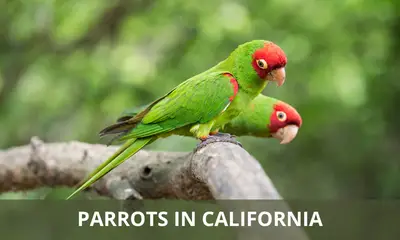
What are the types of parrots in California?
The 13 types of parrots commonly found in California are:
- Red-masked Parakeet
- Blue-crowned Parakeet
- Mitred Parakeet
- Nanday Parakeet
- Rose-Ringed Parakeet
- Yellow-chevroned Parakeet
- Red-crowned Parrot
- Red-lored Parrot
- Yellow-headed Parrot
- Turquoise-fronted Amazon
- Lilac-crowned Amazon
- White-fronted Amazon
All of the feral parrots living in California are descended from birds that were either intentionally or accidentally introduced by humans.
Some of these species have become established as breeding birds in California, and can be regularly observed in many urban areas.
Now let’s dive into the details, and take a closer look at each of these species in order to get the full scoop:
Red-masked Parakeet
Scientific name: Psittacara erythrogenys

The Red-masked Parakeet is the most common parrot found in California.
It can be seen in urban centers throughout the state, including San Diego, San Francisco, and Los Angeles, among others.
These birds were featured in an award-winning documentary in 2003, called “The Wild Parrots Of Telegraph Hill.”
This movie documented the relationship between a homeless man and a flock of Red-masked Parakeets in San Francisco.
These small parrots are mostly green, except for a bright red mask, which sometimes extends to the entire head.
In California, this bird is most common in and around San Diego parks with exotic plants, where it often occurs in mixed flocks with Mitred Parakeets that roost together.
Blue-crowned Parakeet
Scientific name: Thectocercus acuticaudatus
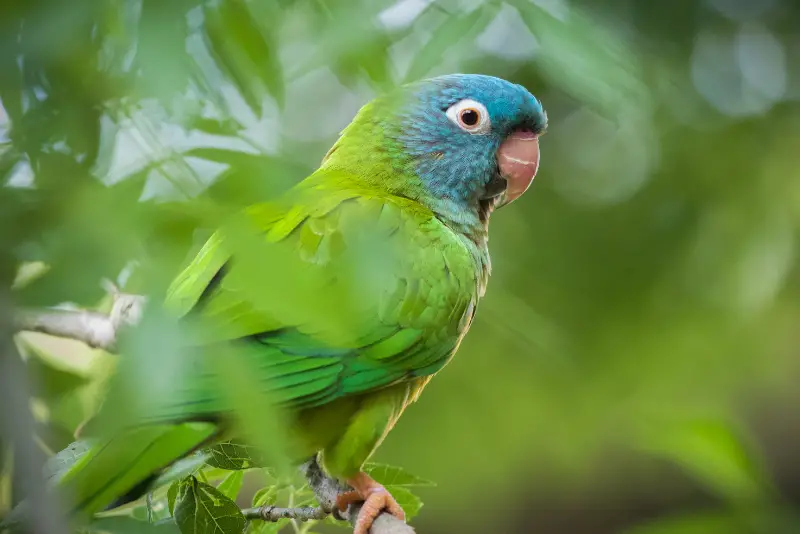
The Blue-crowned Parakeet is almost entirely green, except for a bluish forehead, and a thick white eyering.
In their original range, Blue-crowned Parakeets favor lowland woodland habitats in South America.
These birds have established a breeding population in south California.
Mitred Parakeet
Scientific name: Psittacara mitratus
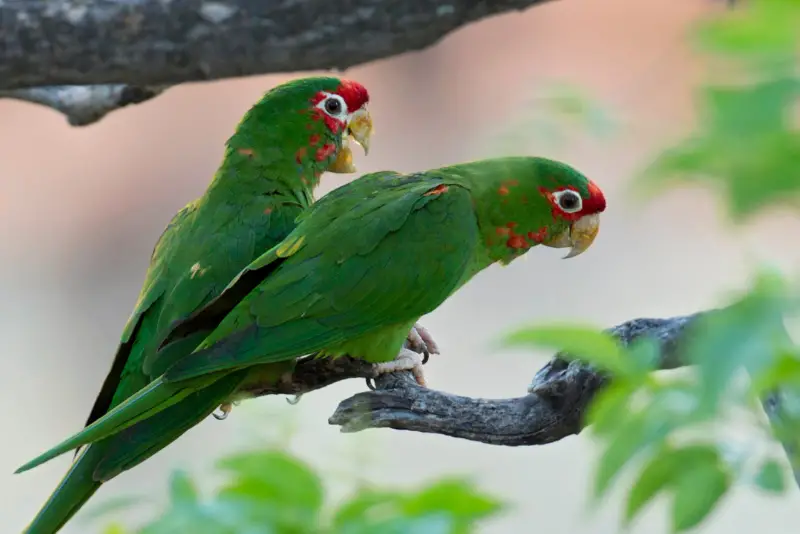
The Mitred Parakeet is another species of parrot that’s originally native to tropical regions of Africa, but can now be found in California as well.
These birds have a short, rounded tail and a long, pointed bill. They are mostly green with a reddish crown and have a pale stripe along their throats.
Mitred Parakeet populations have increased dramatically since the 1970s when they escaped into the wild from zoos across the United States.
They eat fruits, seeds, and insects, and they nest in tree cavities.
Nanday Parakeet
Scientific name: Aratinga nenday
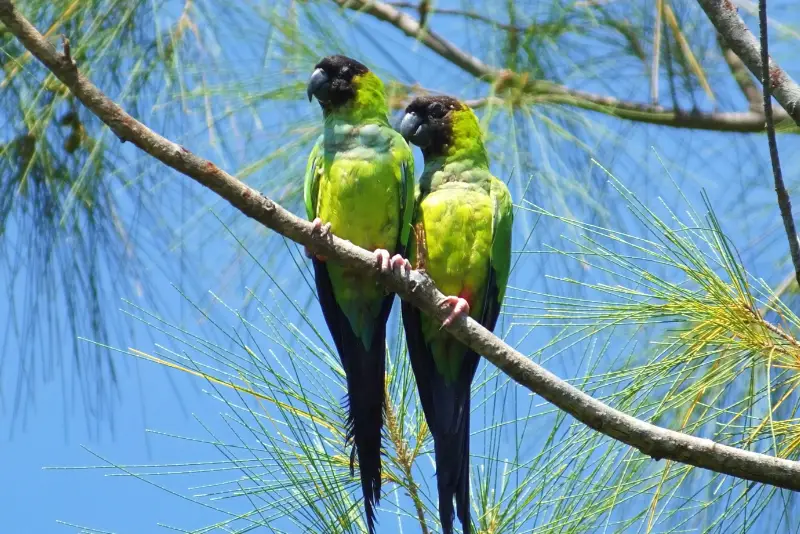
This parrot lives in several areas in South California. Nanday means “beautiful” in Hindi, and it certainly looks beautiful! This green bird has a black head and orange feet.
Its tail feathers have red tips. Male birds can weigh up to 1 pound (0.5 kg), while females weigh less than half as much.
The diet of these birds consists mainly of fruit, seeds, nuts, and insects, and they make loud and distinctive calls at dawn and dusk.
In the Golden State, the Nanday Parakeet is most commonly found in San Diego.
Rose-Ringed Parakeet
Scientific name: Psittacula krameri
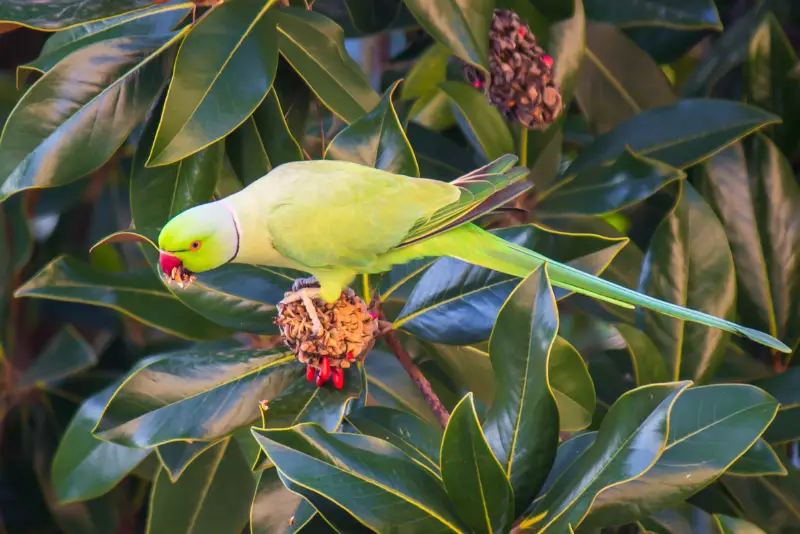
The Rose-ringed Parakeet can be found in wild flocks around California. These birds are also known as Ring-necked Parakeets because of the distinctive rings on their necks.
In California, these parrots are found throughout the year, feeding on fruits, seeds, nuts, insects, and worms and nesting in tree cavities.
Originally from India and sub-saharan Africa, escaped birds have successfully colonized many parts of the world.
Their range now includes Northern and Western Europe, as well as the Arabian Gulf, and California. These parrots are also common in Florida.
Yellow-chevroned Parakeet
Scientific name: Brotogeris chiriri

The Yellow-chevroned Parakeet looks very similar to the White-winged Parakeet, but lacks the white wing patch of the latter.
These birds have adapted very well to urban environments in California, where they feed on plant nectar, and are regular visitors at bird feeders.
The numbers of this bird are increasing, and the population is estimated to be more than 200 individuals in California, most of which are found in Los Angeles.
Red-crowned Parrot
Scientific name: Amazona viridigenalis
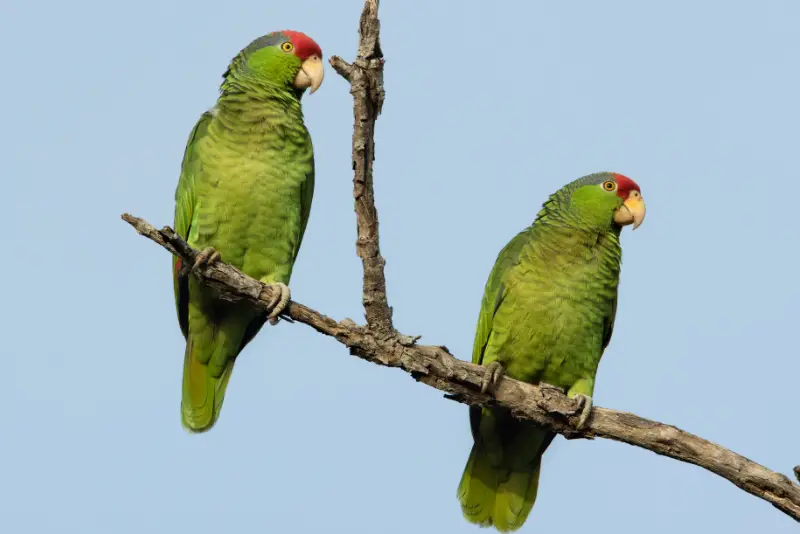
This bird is endemic to the rainforests of Southeast Asia; however, they’re now also found in California, Florida, Hawaii, and Puerto Rico.
In California, the Red-crowned Parrots is most common in Pasadena, where large flocks can be seen roosting together.
Red-crowned parakeets have red crests on their heads and a yellow belly. They have a long, curved beak, and a yellow throat.
These birds are omnivores, eating fruit, seeds, leaves, nectar, and insects. They prefer to live in dense vegetation and often perch on branches while hunting for food.
Red-lored Parrot
Scientific name: Amazona autumnalis

This parrot species has a characteristic red area between its eyes, which explains its name. It is otherwise largely green, except for a blue gray area on top of its head.
The Red-lored Parrot has established populations in several southern states. It has a small breeding population in southern California, but is not as common as other species on this list.
Yellow-headed Parrot
Scientific name: Amazona oratrix
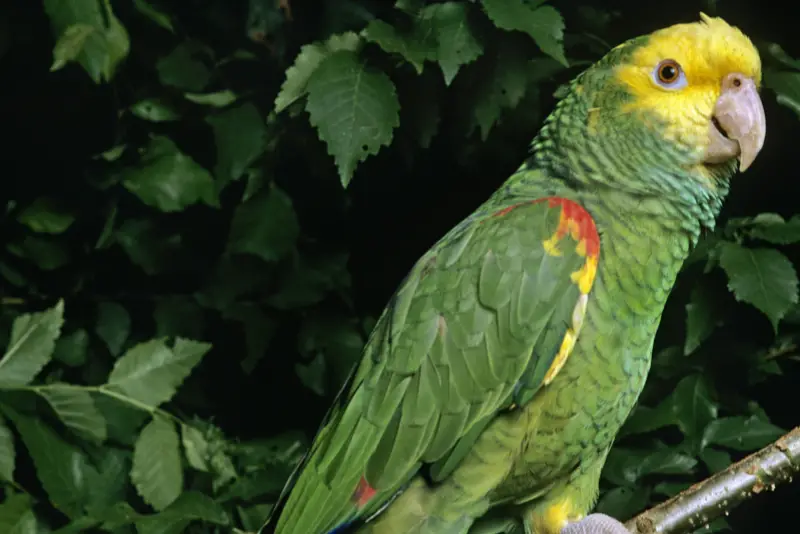
The Yellow-headed Parrot is easily recognizable by its bright yellow head and red patches on its shoulders, which contrast with its green body.
This is an endangered parrot species in its native habitat in South and Central America, and unfortunately the numbers in California have also been declining.
Turquoise-fronted Amazon
Scientific name: Amazona aestiva
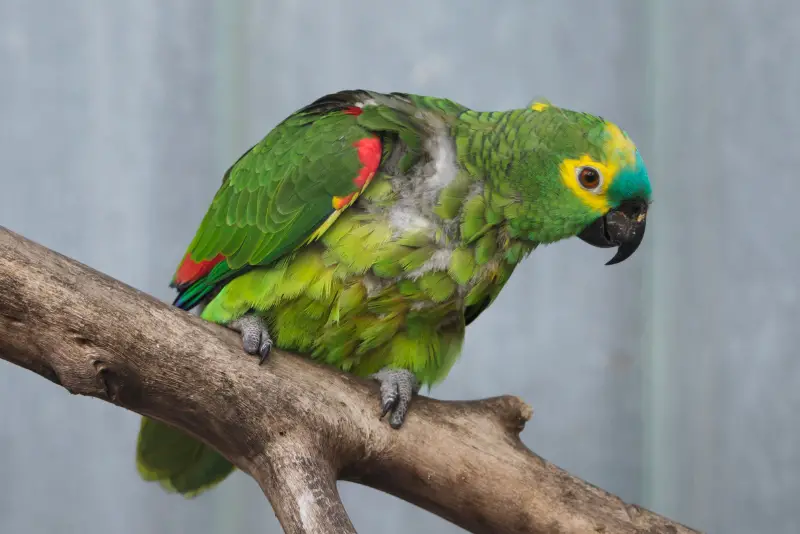
This bird is also called the Turquoise-fronted Parrot, or the Blue-fronted Parrot. Originally from South America, it is one of the most common psittacidae kept in captivity.
These beautiful exotic birds have a green body, yellow face and turquoise forehead, though you need to be quite close to spot the latter.
Due to their popularity in the pet trade, these birds often escape captivity, and this is likely how they got to California.
Lilac-crowned Amazon
Scientific name: Amazona finschi
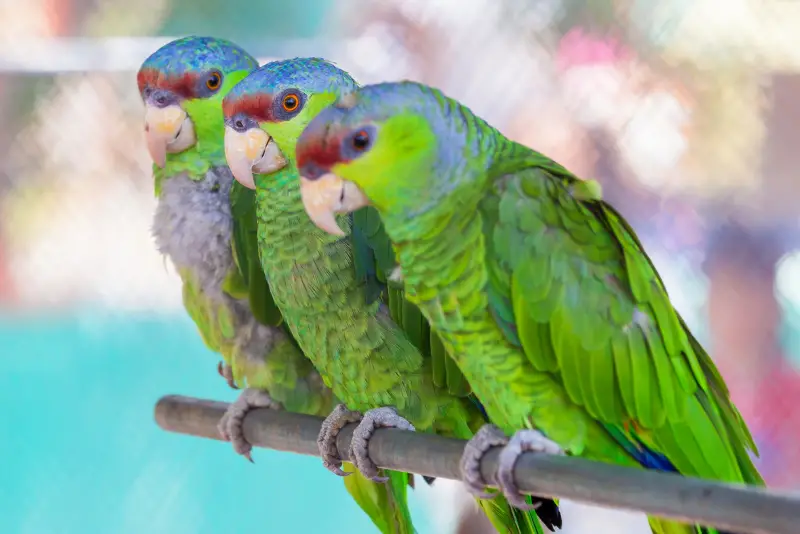
This small bird is originally native to Mexico, but a growing population of more than 100 individuals is also found in southern California.
This parrot is most common in Orange County and San Gabriel Valley.
Similar to most parrots of the genus Amazona, it has a stocky body with a short tail, and is mostly green, but can be recognized by its maroon or lilac forehead.
White-fronted Amazon
Scientific name: Amazona albifrons
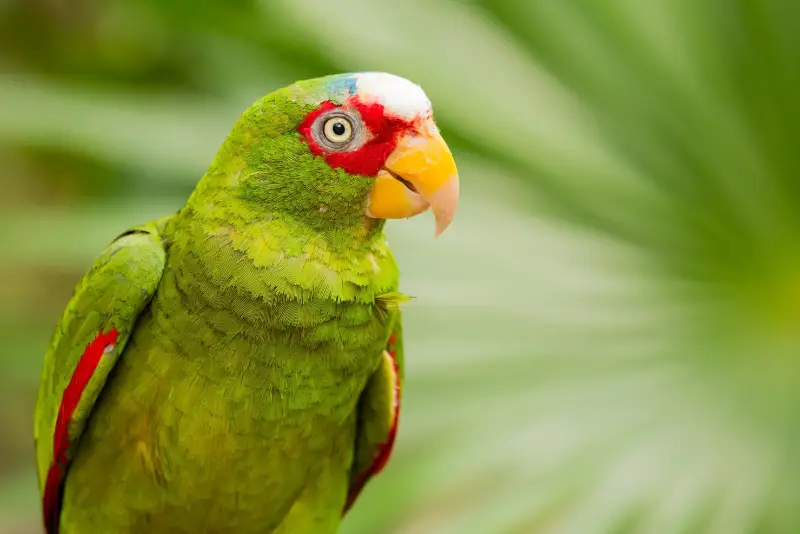
This is the smallest of the Amazon parrots, and resembles a parakeet in size. The best way to identify it is by its white forehead, which is unlike any other similar species.
These birds also have bright red coloring around their eyes, as well as blue plumage on top of their heads.
While it originally hails from Central America, there is now a small feral population breeding in southern California.
How did wild parrots get to California?
Most of the parrots breeding in California are escaped birds from the pet trade, while others have probably been released by humans on purpose.
None of the parrots that currently live in California are native to California.
The success of these introduced birds is probably due to the mild climate in California, combined with access to a wide variety of exotic vegetation in urban habitats.
The rich variety of both tropical and subtropical plants in gardens and parks provides rich foraging opportunities for these birds.
Final Thoughts
California is also home to many exotic birds that are not found anywhere else in North America, and parrots, in particular, seem to be found more frequently in the Golden State than in other states.
From pollinating plants to helping out by keeping pests away, birds play a very important role in our environment.
In the Golden State, you can find plenty of beautiful parrots and parakeets in a range of urban habitats.
If you enjoyed this article, check out our guide to the California birds of prey.
